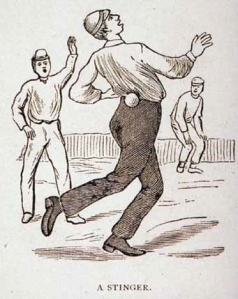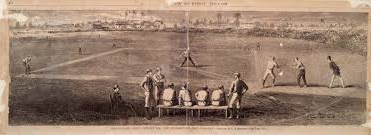
Twenty-First Century Townball
There were plenty of reasons for the New York version of base ball winning out over that of Massachusetts as our National Pastime. Most notably, the geometry of The New York Version makes the game both aesthetically pleasing as well as playable.

The Massachusetts version, in contrast, has an awkward geometry, putting the pitching distance too close to the batter, making it not suitable as a national game.
Many who have played both, however, recognize that there are aspects of the Massachusetts version that make it superior to that of New York.
What if there was a game that had the geometric appeal and playability of The New York version, and yet the aspects of that of Massachusetts that made it so popular in that state for decades before the dominance of the former in this nation?
Twenty-First Century Townball is an attempt to be just that.

Below is a list of the aspects of Twenty-First Century Townball that make it a terrific game. You will see that most of these aspects are exactly in agreement to the 1857 Dedham rules of the Massachusetts version, whereas a few of them are unique. For those that are unique to Twenty-First Century Townball, we tried to find a precedent for each rule from other variants of bat-and-ball games played in this country.
Aspects of Twenty-First Century Townball In Agreement With the 1858 Dedham Rules of The Massachusetts Game
- The use of stakes as bases.
- The fact that first stake is at a right angle from the pitching area.
- Counter-clockwise baserunning.
- The “home” stake not being at the batting point.
- Swift pitching.
- One-out-all-out rule.
- Pegging the runners allowed.
- No walks.
- No Foul Balls.
- Playing up to a given number of runs to win.
- Unlimited number of innings played.
- The number of players on a team.
- A batted ball caught on a fly is an out.
- Three strikes are an out.
- The catcher must catch a ball struck at to be a strike.
Aspects of Twenty-First Century Townball That are Unique
- In Twenty-First Century Townball, the batting order can change after each round. This idea is from cricket where after each inning (or round), the batting order can likewise change. This aspect in Twenty-First Century Townball is necessary, given how difficult it is to score.
- In Twenty-First Century Townball, there is a physical “zone” behind the batter, where if the pitcher hits the zone with the ball, the batter is out. Both cricket and stool ball have a similar aspect. In contrast, although baseball has an invisible “strike zone” that is called by an umpire, hitting the strike zone in baseball is only a strike and not an out, except on the third strike. This aspect in Twenty-First Century Townball is necessary so as to give the batter an incentive to swing the bat.

- In Twenty-First Century Townball, the batter can steal first without having hit the ball. This idea is also from cricket, where the batsmen can run any time after the ball is bowled, even without having hit the ball. In contrast, in baseball, a batter can steal first only when a third strike is dropped. This aspect in Twenty-First Century Townball makes for a very lively game, since the ball is technically “in play” at all times after the first pitch of the inning.

- In Twenty-First Century Townball, a batter does not have to attempt to advance to first base after having hit the ball. This idea is also from cricket, where although the batter does not have to run after having hit the ball, the batting team has a limited number of overs in which to score runs. In Twenty-First Century Townball, this restriction is provided by the fact that if the batter does not advance on a batted ball, a strike is called against him, and that the batter must attempt to advance to first on the third strike. This aspect in Twenty-First Century Townball is also necessary because of how difficult it is to score.
- Twenty-First Century Townball makes use of the Fibonacci Sequence in determining the distances of the basepaths. Although the precedent for the use of The Fibonacci Sequence is not expressly found in any other version of base ball, the idea of perfection in the geometry of the field is found in many variants, most notably, in baseball and in cricket.
What if The Massachusetts Game Had Won Out?
Over the course of its history, the New York Game went through several revisions before it became the version of baseball that we play today. For example, in The New York Game, swift pitching was originally not allowed. Moreover, fielders could catch a fly-ball after one bounce to retire a batter.

The Massachusetts Game, however, has not had the same opportunity to be time-tested until becoming national-game worthy. But if Massachusetts had not succumbed to the pressure to conform to the version of base ball played by the rest of the nation, what would the game look like today? Would it still be played according to the Denham rules of 1857? Or would it have changed over time to adjust the various rule flaws to make it more playable, as in the case of The New York Game?

We here at Twenty-First Century Townball have researched every aspect of the original Massachusetts version of base ball, and have determined that if the Massachusetts style of play had won out over that of New York as the National Pastime, then a version not too much unlike Twenty-First Century Townball would still be being played today.